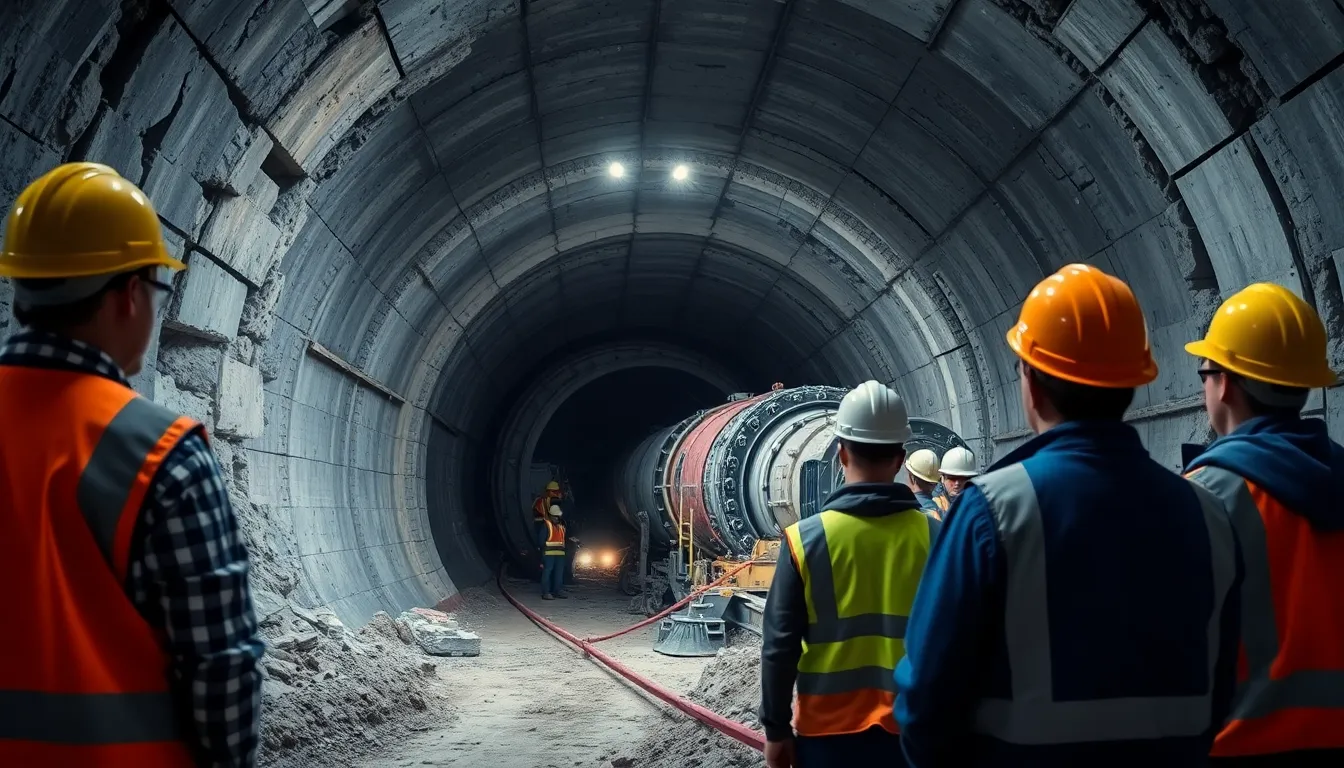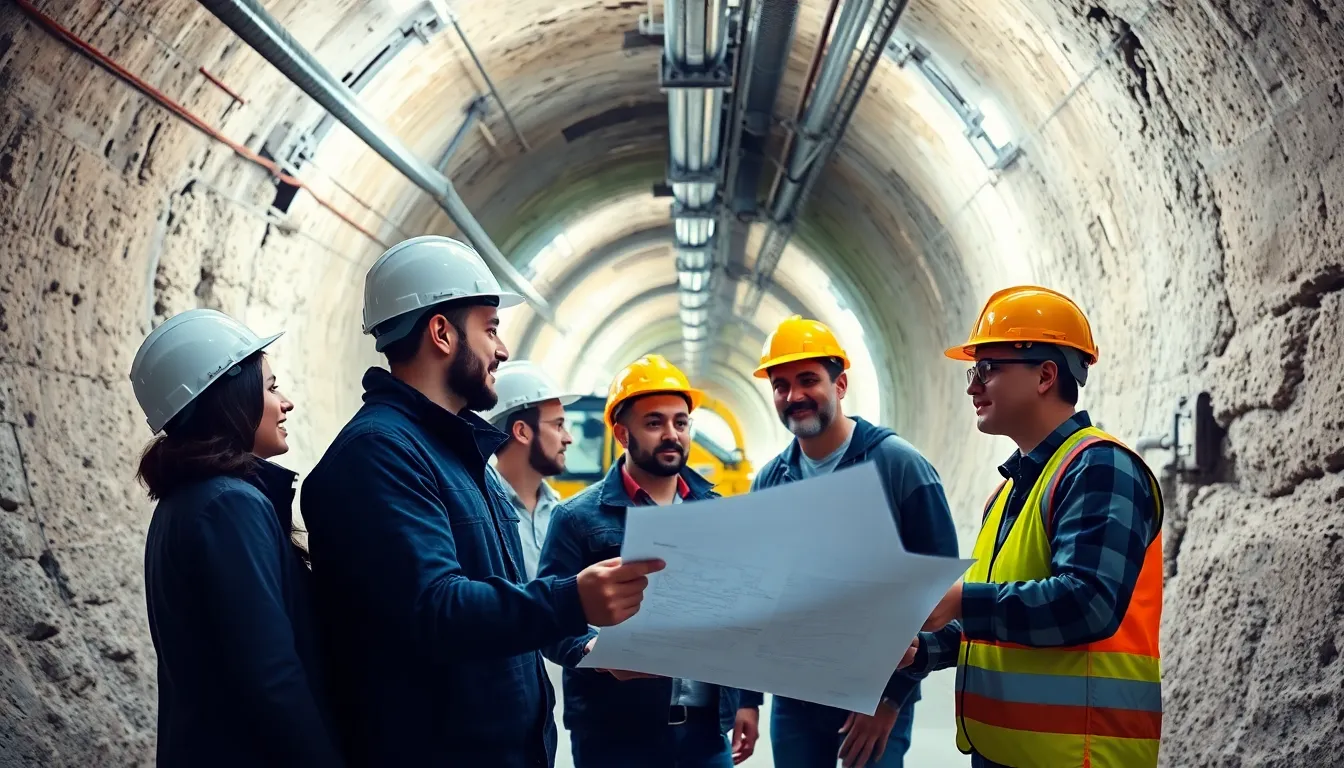Imagine a world where cities thrive underground, free from the chaos of traffic and the hustle of everyday life. Tunnelling and underground space technology are paving the way for this futuristic vision, transforming how we think about urban development. It’s not just about digging holes; it’s about creating vibrant spaces beneath our feet, where creativity meets engineering in a delightful dance.
Table of Contents
ToggleOverview of Tunnelling and Underground Space Technology
Tunnelling and underground space technology encompasses various techniques and methods for creating subterranean environments. Engineers employ specialized machinery and advanced techniques to excavate, support, and construct these spaces. These technologies utilize tunnel boring machines (TBMs) and ground support systems, ensuring stability and safety while addressing challenges like ground conditions and water intrusion.
Innovations in tunnelling have led to remarkable applications across transportation, utilities, and urban development. For instance, cities utilize underground tunnels for transit systems, optimizing space and reducing surface congestion. Many urban planners recognize the potential of underground environments for commercial, residential, and recreational purposes.
Safety regulations and environmental considerations play crucial roles in project planning and execution. Regulatory bodies establish guidelines to minimize risks associated with tunnelling, such as ground subsidence and hydrogeological impacts. Engineers prioritize sustainable practices, enhancing energy efficiency and reducing the carbon footprint of underground projects.
Sustainable design principles integrate seamlessly into the planning and execution of underground spaces. Natural ventilation, efficient lighting, and green materials contribute to healthier environments. These advancements not only enhance the usability of underground spaces but also promote environmental stewardship.
As urban populations continue to grow, the demand for innovative solutions will drive advancements in tunnelling technology. Future developments will likely focus on strengthening the integration of smart technologies within these subterranean environments. Ultimately, tunnelling and underground space technology play a pivotal role in addressing urban challenges and shaping the cities of the future.
Applications of Tunnelling and Underground Space Technology

Tunnelling and underground space technology play a vital role in modern urban development. Various applications emerge, particularly in transportation infrastructure and utilities.
Transportation Infrastructure
Subterranean transportation systems significantly alleviate surface congestion. Engineers design underground transit networks, including subways and elevated roadways, to enhance passenger movement. Tunnel boring machines efficiently excavate routes while ensuring structural integrity. Innovative designs, such as modular tunnels, offer flexibility for future expansions. Cities like New York and Tokyo exemplify successful underground transit systems that connect vast populations and reduce travel times. With increased demand for efficient transportation, investments in tunnelling continue to gain momentum.
Utilities and Energy
Underground space technology optimizes utility and energy management in urban environments. Water supply pipelines, sewage systems, and electricity conduits all benefit from subterranean placement, enhancing safety and aesthetic appeal. Engineers deploy tunnelling techniques to minimize ground disturbance and protect natural resources. Projects often incorporate renewable energy sources, such as geothermal installations, utilizing underground heat for sustainable power. This approach not only reduces the environmental footprint but also supports energy efficiency. As municipalities expand, utilizing underground space for utilities becomes increasingly essential.
Techniques in Tunnelling
Tunnelling techniques play a vital role in the development of underground spaces, ensuring efficiency and safety. Several established methods coexist, catering to various project requirements.
Conventional Tunnelling
Conventional tunnelling relies on traditional techniques that include drill-and-blast methods and open-cut excavation. Drill-and-blast involves drilling holes into rock formations, filling them with explosives, and subsequently detonating these charges to break rock. This method works well in hard rock environments, offering efficient excavation rates and adaptability. Open-cut excavation, on the other hand, entails digging a trench to create tunnels. This method simplifies access for machinery and laborers, though it often requires extensive surface disruption and poses challenges in higher groundwater areas.
Modern Tunnelling Methods
Modern tunnelling methods utilize advanced technology to refine the excavation process. Tunnel boring machines (TBMs) represent a significant innovation, capable of excavating large diameters with precision. These machines reduce surface impact while enhancing safety by providing a stable tunnel face. Another modern approach is the use of cut-and-cover techniques, ideal for urban environments. Engineers typically employ these methods for shallow tunnels, minimizing environmental disturbances while accommodating utility installations. Additionally, the incorporation of digital technologies enables real-time monitoring and predictive maintenance, enhancing efficiency and project timelines.
Challenges in Tunnelling and Underground Space
Tunnelling and underground space technology face significant challenges that impact project execution. These challenges include environmental, safety, and risk management aspects that engineers must address.
Environmental Considerations
Environmental impacts require careful assessment during tunnelling projects. potential disruptions to local ecosystems and existing water resources can arise. Noise pollution poses a concern for nearby communities, thus necessitating noise abatement measures. Engineers incorporate sustainable practices and green materials into their designs to mitigate environmental harm. Compliance with environmental regulations also ensures that projects align with sustainability goals.
Safety and Risk Management
Safety remains a paramount concern within the tunnelling industry. Engineers conduct thorough risk assessments to identify potential hazards, including ground instability and water intrusion. Mitigation strategies must be developed to minimize these risks effectively. Implementing stringent safety protocols throughout the construction process protects workers and the public. Regular training and safety drills reinforce a culture of safety on-site, ultimately ensuring project success.
Future Trends in Tunnelling and Underground Space Technology
Innovations in tunnelling technology focus on sustainability and efficiency. Advanced materials are becoming prevalent, allowing for longer-lasting structures while minimizing environmental impact. Engineers increasingly employ data analytics and artificial intelligence to enhance project planning and site monitoring, ensuring higher safety standards and reduced costs.
Smart technologies integrate sensor systems into underground environments, providing real-time data on structural integrity and environmental conditions. As cities embrace digital transformation, the deployment of automated systems within tunnels will streamline maintenance processes and improve safety protocols.
Urban planners are prioritizing multi-use underground spaces to accommodate various functions. For instance, tunnels may host utilities, transportation, and commercial activities, creating vibrant environments that support community needs. This approach fosters ease of navigation and accessibility, significantly enhancing user experience.
Regulatory frameworks adapt to embrace emerging technologies, ensuring projects align with environmental and safety standards. Stakeholders continually assess risks associated with tunnelling projects, driving the adoption of innovative practices to mitigate potential hazards. Testing and modeling are essential for predicting challenges before they arise, allowing engineers to develop effective solutions.
The industry also focuses on public engagement, inviting community input during project design and planning stages. This inclusion helps address concerns about environmental impact and disruption while promoting transparency and trust. Sustainable practices, such as utilizing green construction materials and implementing energy-efficient systems, further contribute to the overall success of tunnelling projects.
Collaboration among various sectors is critical for advancing tunnelling and underground space technology. Partnerships between governments, private companies, and research institutions foster innovation and knowledge sharing. These collaborations lead to the development of optimized structures capable of supporting burgeoning urban populations and alleviating surface congestion.
Tunnelling and underground space technology are redefining urban landscapes and addressing the challenges of growing populations. As cities look to the future, the integration of innovative techniques and sustainable practices will play a crucial role in creating functional subterranean environments.
Engineers and urban planners are collaborating to ensure these underground spaces are not only efficient but also enhance community living. By prioritizing safety, environmental considerations, and smart technology, the industry is poised to transform how urban areas function.
This evolution in tunnelling technology promises to alleviate surface congestion and foster vibrant underground communities, paving the way for a more sustainable urban future.




